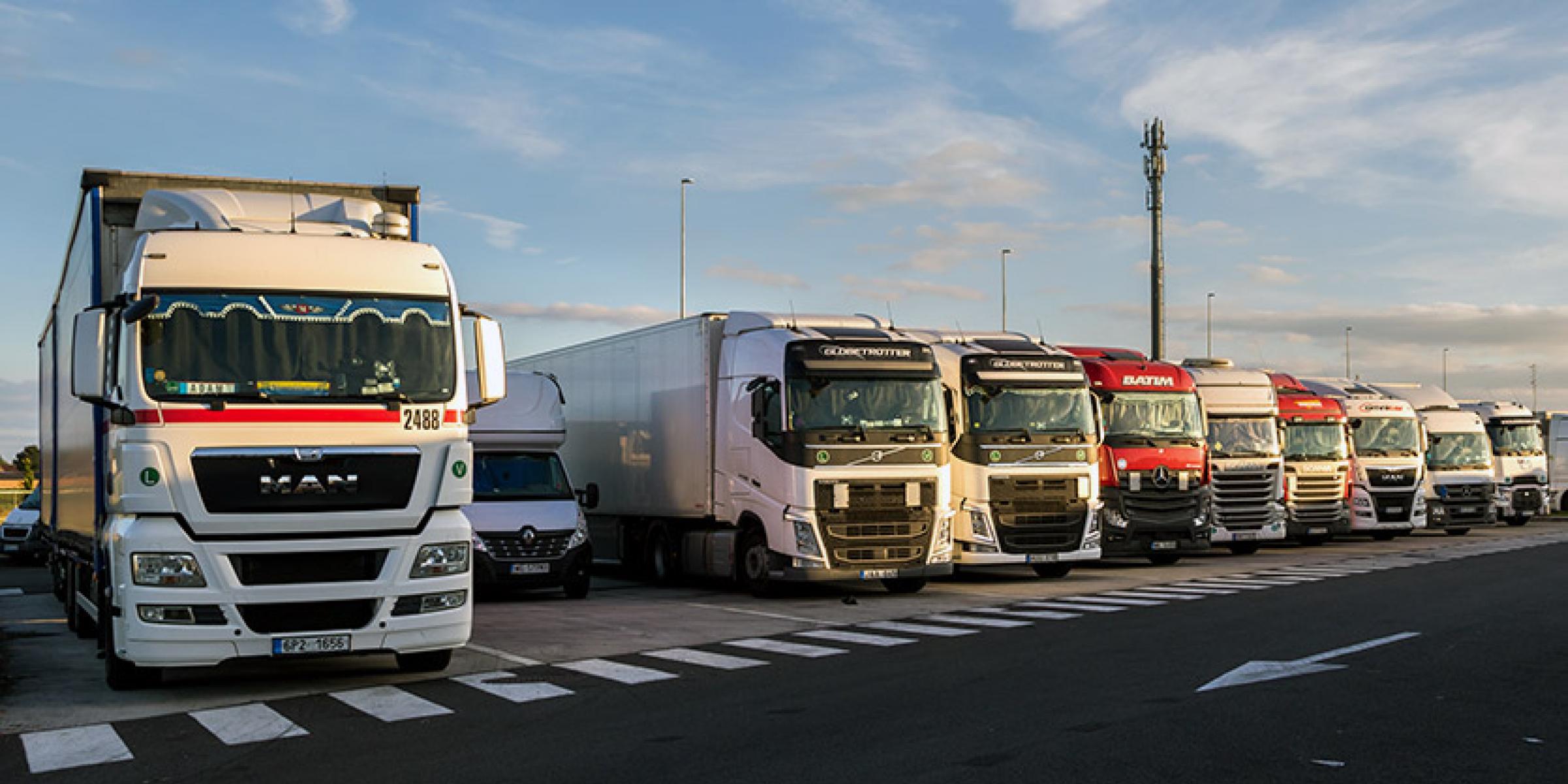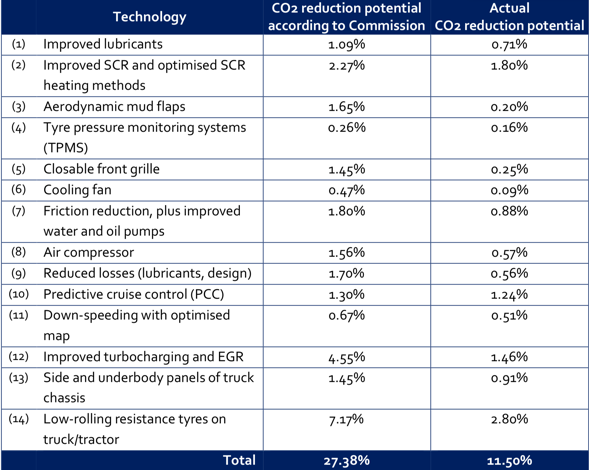The European Automobile Manufacturers Association (ACEA) is at again. The lobby organisation of car and lorry manufacturers dictates policy to the EU, which is then ordered by Germany ot be adopted into law. Let us see what happens this time.
By Felipe Rodríguez, Researcher at ICCT
Cross-posted from the ICCT Website

It’s been four months since the European Commission released its long-awaited proposal for regulating the CO2 emissions of trucks for the first time in Europe. In the record-setting summer heat, EU legislators, member state governments, truck manufacturers, and the civil society have had plenty of time to examine the ins and outs of the proposed CO2 standards.
The Commission’s proposal mandates a 15% cut in CO2 emissions from trucks by 2025, and a 30% cut by 2030. As we’ve recently argued, this level of ambition is not only insufficient to meet EU’s climate change mitigation targets, it also does not reflect the Commission’s findings on what is possible and cost-effective. In the impact assessment supporting the CO2 standards proposal, the Commission identifies that CO2 cuts of 20% in 2025 and 35% in 2030, relative to the 2019 baseline, are not only technologically feasible but would result in greater economic and societal benefits.
The industry sees it differently. In a recent publication, the European Automobile Manufacturers Association (ACEA), the lobbying organization of car and truck makers, describes the Commission’s impact assessment as flawed and calls for a paltry 7% cut by 2025. This represents a reduction 1.2% per year, close to the same reduction level they claim to have achieved in the absence of CO2 standards. That is, they are calling for business as usual.
But let us dive into ACEA’s criticism of the Commission’s impact assessment. The lobbying organization claims that the Commission overestimated the CO2 reduction potential of several technologies and presents its own alternative estimates (see the table below).
Source: ACEA
On the face of it, it seems like ACEA’s and the Commission’s estimates are worlds apart. A closer inspection, however, reveals that ACEA has deceptively presented the Commission’s numbers to push its case. Here’s the recipe for this disingenuous soup.
- Simmer the Commission’s CO2 reduction numbers until they look larger.
- Pinch the Commission’s estimates on the current technology penetration out from the mix.
- Blend the reduction potentials from the different technologies using a flawed methodology to make the total look bigger.
- Chop the CO2 reduction potential of your own technologies and add them to the mix.
- Serve cold and hope nobody looks too closely.
Let us scrutinize each one of these steps.
In its position paper, ACEA deliberately inflates the CO2 reduction estimates presented in the Commission’s impact assessment. If you compare ACEA’s table above to the Commission’s impact assessment you will find several discrepancies. Check for yourself (Table 2, column 5). It’s ok, I’ll wait.
See what I mean?
While you were looking at that table in the impact assessment, you might have also noticed a column labeled “implementation rate.” These values correspond to the penetration rate of the individual technologies across the EU fleet in 2016. The Commission took into consideration these penetration rates when calculating the effective reduction potential of the individual technologies. For example, if a technology reduces CO2 emissions by 10%, and has been adopted by half of the HDV fleet, then the potential that the Commission uses in its analysis is only 5% (i.e., 10% times one-half). This is well documented in the JRC study supporting the impact assessment (see page 7 of that report).
Once the current technology uptake is accounted for, the Commission’s and ACEA’s estimates are not that far apart from each other. As a matter of fact, the Commission’s estimates for some technologies are below ACEA’s. I summarized the actual numbers from the impact assessment in the table below, so you can judge for yourself.
| CO2 reduction potential according to ACEA | CO2 reduction potential from the Commission, without adjusting for tech. uptake | CO2 reduction potential from the Commission, adjusted for 2016 tech. uptake | |
|---|---|---|---|
| Improved lubricants | 0.71% | 1.1% | 1.08% |
| Improved SCR and optimized SCR heating | 1.80% | 2.2% | 1.98% |
| Aerodynamic mud flaps | 0.20% | 1.6% | 1.60% |
| Tire pressure and monitoring system | 0.16% | 0.2% | 0.16% |
| Closable front grille | 0.25% | 1.3% | 0.98% |
| Cooling fan | 0.09% | 0.4% | 0.28% |
| Friction reduction, improved water and oil pumps | 0.88% | 1.7% | 1.62% |
| Air compressor | 0.57% | 1.4% | 1.37% |
| Reduced losses (lubricants, design) | 0.56% | 1.5% | 0.75% |
| Predictive cruise control | 1.24% | 1.0% | 0.45% |
| Down-speeding with optimized map | 0.51% | 0.2% | 0.17% |
| Improved turbocharging and EGR | 1.46% | 3.9% | 2.15% |
| Side and underbody panels of truck chassis | 0.91% | 0.6% | 0.57% |
| Low-rolling resistance tires on truck/tractor | 2.80% | 5.9% | 3.36% |
| Total | 11.5% | 20.8% | 15.3% |
Let me turn your attention now to the way that ACEA is combining the potential of the different technologies to arrive at the total shown in the table above. One could be excused for thinking that the combined potential of the technologies is the simple sum of the individual contributions. However, this approach is flawed. For example, if you have two technologies that can be applied simultaneously, each one reducing CO2 emissions in 50%, you do not get a 100% reduction, but a 75% reduction (50% times 50% is 25%). The same logic applies to calculating the combined potential of a larger set of technologies. Of course, ACEA knows this. They used this approach to calculate the combined reduction of their alternative reduction potential estimates, resulting in the combined 11.5% reduction shown in its table above. They did not, however, employ the same, correct, approach to the Commission’s numbers. For that calculation, they somehow forgot to use the right methodology, and simply added the individual contributions, resulting in a wrong, larger, and misleading total CO2 reduction potential.
Still with me? Great, we are almost done going over this off-putting recipe. Disputing the CO2 reduction potential of the individual technologies provided by ACEA would turn this blog into an engineering treatise. Still, let me do some illustrative fact checking on a couple of statements presented by ACEA as flaws in the Commission’s assessment.
- ACEA states that the CO2 reduction of the technologies above for the whole regulated vehicle fleet is lower than for the long-haul tractor-trailer used by the Commission as an example. Although this statement is true, it ignores the fact that the Commission also ran the numbers for the other vehicle groups when setting the targets. It also ignores that close to 80% of the tonne-kilometers are driven by long-haul tractor-trailers, so they do matter a lot.
- ACEA claims that the CO2 reduction of low rolling-resistance tires is overestimated by a factor of two. To fact check this statement, I ran some VECTO simulations. Currently, heavy-duty vehicles are equipped with tires with a rolling resistance of 5.5 N/kN, corresponding a tire efficiency class C. Switching to class A tires, which are already available in the market, would reduce the truck rolling resistance to around 4 N/kN and result in a CO2 reduction of 3.8%. So, the Commission is actually being conservative in its assessment. Note that this is just looking at the truck’s tires, not the trailer’s.
- ACEA alleges that the Commission is double counting the following three technologies: “Improved lubricants”, “Friction reduction, improved water and oil pumps”, and “Reduced losses (lubricants, design).” I sympathize with ACEA’s confusion, since these three technologies do sound similar. However, as you probably saw coming, they are in fact different. “Improved lubricants” refers to the use of oils with low viscosity at high temperature and high shear stress, which reduce the friction between the piston rings and the cylinder. The use of these oils requires a careful design of the engine, and it is not as easy as changing the oil of any old motor. “Friction reduction, improved water and oil pumps” refers to areas of the engine other than the piston-cylinder interface. For example, the water and oil pumps that circulate the vital fluids of the engine, and other rotating components of the engine, such as the camshaft and crankshaft, are significant sources of engine drag. Lastly, “Reduced losses (lubricants, design)” refers to friction reduction outside of the engine, that is in the transmission and drive axle. In summary, there is no double counting of friction related technologies in the Commission’s assessment.
- ACEA states that the technologies “Improved turbocharging and EGR” and “Improved SCR and optimized SCR heating” are incompatible. All I can say is that they might want to pay a visit to one of their competitors at the upcoming IAA truck fair in Hanover when they showcase a new system doing exactly that: integrating the turbocharger and aftertreatment system, improving the SCR heating, and reducing fuel consumption and NOx emissions simultaneously.
If this technology discussion has whetted your appetite, you are in the right place. In the past two years, the ICCT has commissioned and performed several detailed technology assessments to estimate the CO2 reduction potential of European trucks (this one, also this one, this other one, and this one). Our findings show that, if anything, the Commission acted too cautiously when assessing the potential of current and future technologies and proposing the respective CO2 reduction targets.
Now, you might rightly wonder: If the combined reduction potential of the Commission’s technology assessment is around 15%, how is it that the impact assessment identifies a cost-effective reduction potential of 20% in 2025 and 35% in 2030? The answer is simple. The technologies shown in the impact assessment, and listed in the tables above, are only a subset of the complete set of technologies analyzed by the Commission and its contractors. However, the publication of the full technology potential study underpinning the impact assessment is still pending.
Thankfully, ACEA’s concoction is unlikely to go down anyone’s throat. However, if truck makers are genuinely willing to commit to a binding and ambitious CO2 reduction target (as they claim in ACEA’s paper), they should instruct its lobbying arm to refrain from sowing confusion with purposefully misleading analyses and alternative facts. After all, it is in the industry’s best interest that this proposal goes through the law-making process as smoothly as possible, to ensure the regulatory certainty required to plan their development cycles and long-term investments.




Be the first to comment